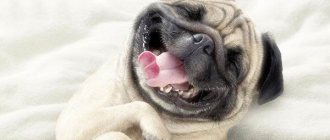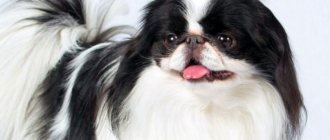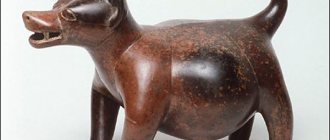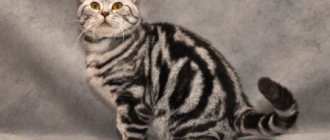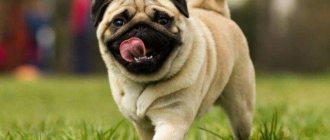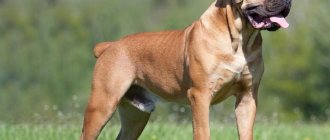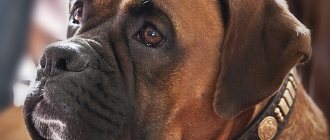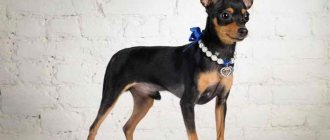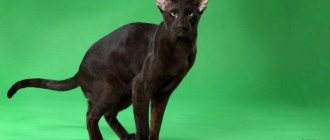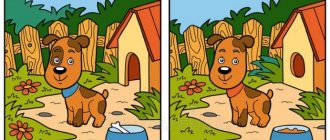Who is this dog suitable for?
The pug fits perfectly into the family and becomes incredibly attached to its owner.
He is very sensitive and, if he sees that his owner is depressed, he tries in every possible way to provoke him to play. He sits down next to him, attracts attention, makes faces so funny that everyone, whether he wants it or not, lifts his spirits. Pugs are ideal as a companion for children and older people, because these dogs do not need a lot of exercise. Also, these pets practically do not cause problems, so anyone can cope with them, even those who have absolutely no experience in keeping a dog in the house. Don't expect the pug to guard your home, because he loves guests so much that he will happily welcome everyone. If the pug finds himself in the center of attention, his joy will know no bounds. He does not tolerate loneliness very well; it is ideal if someone in the family always has the opportunity to be at home with the dog. He can bribe all household members with his ability to make various sounds: puffing, clearing his throat, snorting, and it all depends on the situation and mood. You should communicate with this pet calmly and carefully, because he perceives everything so closely that even a slight raising of his voice is a punishment for him.
Classic pug or Lo Shi: how to choose?
It all depends on your preferences and desire to deal with transporting a puppy from the United States. Lo Shi is difficult to find in Russia, so there is a high risk of being scammed. There are quite a lot of nurseries for ordinary pugs throughout our country.
Care and feeding for both breeds are almost the same.
The Lo Shi and the Pug are similar, so only choose an American Stunted Pug if you are a fan of the breed, or if size is of fundamental importance to you.
Pug appearance
The Pug is a massively built dog with a square and powerful body. It has a fairly compact body, a straight back, a deep-set chest and a strong lumbar region. The tail is tightly curled into a ring (usually double) and carried from the side. The head is wide, massive, the muzzle is shortened. The outer part of the muzzle is covered with deep wrinkles that stretch from the inner corners of the eyes to the outer part of the muzzle. The wrinkles on the forehead resemble a tiara. The eyes are dark, bulging, have a kind look, the ears are small and thin, velvety to the touch, set high and curled, when worn, their shape resembles rose petals.
The way the pug moves is of great importance; the dog should move with a characteristic rolling step. This step is typical only for dogs with correct body structure, a level topline and straight hind legs, well placed under the body. A firm step and throwing the forelimbs high forward when running reduces the show class of the pug.
Coat and color
The pug's coat is short, thick and smooth. It is soft to the touch; if it is hard and wavy, this is considered incorrect. The color of the pug is silver, tan, apricot or black. If the coat is multi-colored, then the mask, ears and the so-called diadem on the forehead should be black, forming a contrast with the main color. Pugs shed throughout the year, so they need frequent brushing.
Breed characteristics
Any artificially bred breeds require more attention than standard ones, especially in the case of experiments with sizes. The bones of such dogs are more fragile and thin, the immune system is weaker, which is potentially dangerous to health. Mini-pugs (depending on crossbreeding) reach a weight of 1.3–4.5 kg and up to 21 cm in length.
In any case, these are small, short-legged dogs with a flattened muzzle and bulging round eyes. Folds form on the muzzle, and the color of the nose can be any color. The Luo Ji body is strong, small, and has a broad chest. The tail is short, like a donut. The dog's coat can be of any color, but it is short and smooth. By nature, pugs are slightly lazy, but they are wonderful companions and friendly to other fauna.
Characteristics of a pug include kindness, playfulness and stubbornness.
Origin story
The history of the origin of pugs goes back to the Far East; this breed is considered one of the oldest. The first mentions of dogs that resemble pugs in appearance date back to the 2nd and 1st centuries BC. n. e. During the Song Dynasty, these dogs were called Lo-Chang-Shi or Lo-Shi. Confucius described pugs as short-legged and short-nosed dogs. Their images are found on figurines and porcelain vases from that period. These animals were considered very valuable, lived in luxury and were universally respected. It is believed that the "Imperial Book of Dogs" depicts the ancestor of the current pug, although its appearance is slightly different from the dog we are used to seeing today.
In the 16th century, pugs were brought to Holland on merchant ships, and they quickly became favorites of the royal family, descended from the Orange dynasty. Particularly popular was a dog named Pompey, who sensed an approaching attack and sounded the alarm, thereby saving the life of his owner. After this incident, the pug began to be depicted on the coat of arms of the Orange dynasty. It is believed that pugs came to England in 1688 with Prince William of Orange, who later became King of England. During his reign, from 1689 to 1694, pugs took the place of dwarf spaniels in the royal court and became the favorites of all noble persons.
For their current appearance, pugs should be grateful to the British, who founded the British Pug Club in 1882. Only in the 19th century did the fashion for them begin to fade a little, but already in the 20th century they again became dogs that began to be evaluated at exhibitions, as well as companion dogs. Among the fans of this breed were such people as: philosopher William Hogarth, Queen Victoria, Napoleon, Louis XIV, Duke and Duchess of Windsor, Josephine, fashion designer Valentino and many others.
Little mini pug: American lo shi
If you are wondering what kind of small dog you can get in a city apartment and, if possible, walk it less often, then we present to your attention the American short pug.
This new mini breed is just beginning to gain well-deserved popularity in America, and may be just the thing for you.
American mini pug - what kind of breed? Where did she come from? Where to buy and how to care? And in general, are there any dwarf pugs? Let's figure it out together.
The Lo-Shi breed originated in ancient China and was bred for a long time exclusively for the imperial court and those closest to it. Initially, these decorative dogs were more similar to modern Pekingese : a small protruding nose, a short head, but short hair. This same breed later led to the emergence of the modern pug
.
Unfortunately, over time, after the strengthening of trade ties with Europe, precious dogs almost completely lost their original gene pool as a result of uncontrolled crossing with other breeds.
The American pug Lo Shi, as an independent breed, reappeared relatively recently - only 30 years ago, and has not yet been officially recognized by the International Canine Federation. Breeder Rebecca Mance, who studied the history of Lo-Shi for a long time, began to revive it in the 80s of the last century, and, by crossing a pug and a Pekingese, again breathed life into this ancient imperial breed.
Pug character
The pug has an excellent character; the dog is a kind and very sociable creature. He loves to play and have fun, but the dog is not considered very active. When they are young, pugs have more fun and run around the house more quickly, but with age this desire becomes less and less in them. The duration of active actions of a pug is minimal.
This is a very kind, affectionate and gentle animal. They are perfect for experienced dog owners and for beginners in this matter. Pugs are excellent pets. They have a friendly nature and a calm temperament.
This breed is also distinguished by its quick wit and great intelligence. You can easily teach your pug different commands. The dog will keep you company when relaxing on the sofa, while watching your favorite movie and during a short walk in the park.
Is a pug the ideal dog? Naturally not, like other breeds, this dog’s character has its drawbacks. She can steal food, constantly dig holes in your flower beds and vegetable gardens, and bark loudly and unreasonably. This can happen when your pug is bored or has no one to look after him.
Start training your pug from the first days of his stay in your home. Being a small puppy, he is ready to absorb any information. You don't have to wait until he is 6 or 7 months old. At this age, pugs become more stubborn and disobedient. Therefore, it will be very difficult to teach him something.
If you do not have time for training, then you can take it to small animal courses, where professionals will teach your pug basic commands. But in this case, you need to make sure that your pet is not infected by other dogs, which will also be brought to specialists for training. Vaccinations can be the best prevention.
Reviews
Many owners of such babies speak well of them, saying that they are the sweetest creatures with a peaceful disposition and a cheerful character. They love to lie on the sofa or armchair, play with children or chat with family members. When everyone is eating at the table, they usually sit around and beg for pieces, and it is very difficult to restrain yourself from giving them prohibited foods.
Such dogs are very bored without their owners and if they are left at home alone, they can then remain glued to the person for hours and follow on his heels, and when he is about to leave, they will look with eyes full of tears. They are generally characterized by a sad expression on their face at any given time.
Some claim that mini pugs have become a full-fledged part of the family for them; everyone at home takes care of them, they often cheer up and make people happy. Such creatures cannot help but touch you; they are funny and resourceful. The only negative is the snoring and grunting that they constantly emit, which can be annoying for some. However, over time you can get used to it, and the sounds become almost inaudible.
Maintenance and care
Try to take care of your pug as much as possible: trim it and bathe it more often. If you do not have time for this, then entrust this work to a specialist or a loved one.
Trimming a pug's coat is very easy. Go over your dog's entire body with a special brush and remove all dead hair. There will be a lot of them, it’s a pug after all. They shed almost all year round and there is nothing you can do about it.
Clean your pug's wrinkled face, especially around the nose. These dogs develop wrinkles very often, so you will have to perform the cleaning procedure frequently. After removal, wipe the wrinkle area with a cosmetic sponge and dry the area to prevent infection.
Bathe your pug in the bathtub (or basin) as needed. Thanks to new gentle dog shampoos, you can bathe your pet weekly. At the same time, the shampoo will not have any negative effect on the dog’s fur. Brush your pug's teeth with a special paste from your veterinarian, and also trim his toenails (preferably once a week).
Caring for a pug will give you only positive emotions, there is nothing complicated or problematic about it. This dog is worth taking care of. She will then definitely pay you back with a cheerful mood and positive emotions.
How to choose a puppy
- Buy puppies from nurseries and seek professional advice.
- Buy one that has pedigree documents, so you will have the opportunity to participate in exhibitions.
- Pay attention to the puppy's health: it should be brave, energetic, have clean ears without any odor, clear eyes, white teeth, the coat should be clean, free of dandruff, and shiny.
Pug training and training
Since pugs are distinguished not only by their good intelligence, but also by their persistence and stubbornness, they quickly get bored with various monotonous exercises and games. This becomes quite a serious problem in training these dogs. And the frequent stupid antics of pugs can even become an insurmountable barrier to training for an untrained dog breeder.
Fortunately, these dogs also have another quality - a great desire to please their owner. Therefore, with consistent and persistent training, success in training pugs is guaranteed. These funny dogs love praise, so this pet’s tendency must be used in training. Always praise your dog for even the slightest success. Pugs are also distinguished by their love for treats, which can be an excellent reward for every completed command.
It is necessary to begin training a pug from the moment the puppy appears in the house. The first six months are the most important period. If you skip it, the training will be much more difficult.
Many pug owners are concerned that their pets are very difficult to potty train. The thing is that pug puppies, under the age of six months, have difficulty controlling their stomach. This is a certain feature of the breed. So don't be nervous. Be patient and persistent and your pet will definitely bring joy to you and your family. The main thing is to give him positive emotions and then the results will not keep you waiting long.
Where to buy a puppy
Since this breed has not yet become widespread in Russia, buying a puppy will be a costly and time-consuming task. The breed's breeders are located in the USA, and only three of them are licensed, so you should take care to book and deliver your future pet in advance. Breeders can be contacted directly by email.
- Becki Manns [email protected] net Donna Marshall [email protected] com John [email protected] net
Puppies should be looked for and booked in mid-winter or late summer. Services such as puppyfinder can also help with this. com or hoobly. com. Sometimes advertisements appear one-time on avito, but this is the exception rather than the rule.
Health and illness
Pugs are prone to the condition of brachycephalic syndrome. This is when the walls of the nostrils and the shape of the nose prevent the dog from breathing fully. The first signs of the syndrome: cyanosis, noisy breathing, regurgitation of foam, difficulty swallowing, periodic cough. Exacerbation of the syndrome can be caused by excessive obesity of the pet, and its constant presence in a hot and humid place. Therefore, it is very important that your Pug is not overweight and that he is kept primarily in a cool, dry area. If the dog has very strong brachycephalic syndrome, then it needs to be sent for surgery to correct the structure of the nose.
A pug can also get encephalitis (this is an inflammation of the brain) and then the dog will begin to have seizures. Death is also possible. It is not yet possible to prevent and cure this disease.
This breed can also develop orthopedic problems. In particular, necrosis of the femoral head may develop. This can cause your Pug to be unable to step on its back leg when walking. This disease is better known as Legg-Calvé-Perthes disease. According to research from the American Pet Association, pugs are more likely than other breeds to develop Perthes' disease. The first signs can be observed at an early age of the dog (when it is only 3-4 months old). During this period, lameness will appear. Then urgent surgical intervention is necessary, after which your pet will be able to live a more or less normal life.
In pugs, the vertebral part can also be damaged. You will immediately notice this by the dog’s gait and behavior. Only surgery will help in this case.
In addition to all of the above, pugs often suffer from toothaches. The structure of their mouth is very uncomfortable, so tooth damage is possible.
Despite their small size, Pugs can also have hip problems. But, compared to larger dogs, Pugs do not require surgery to treat their joints.
Can my Pug get all of these diseases? They can, but the probability is very low. This is provided that you monitor the physical shape of your pet.
Once you have a pug puppy in your home, forget about chaotic and disorderly feeding of the dog. You should always make sure that your dog does not become obese. Because this is one of the main sources of various diseases. Keep an eye on your pet now so you don’t overpay for treatment later.
Description
- He has a compact build and is stocky. Square format (the length of the body is almost equal to the length at the withers).
- The head is large, round in shape, wide. The muzzle is flattened, blunt, square, with distinct deep wrinkles. There is a fold above the nose (solid or intermittent), the bridge of the nose is weakly expressed (its complete absence leads to breathing problems), the nasal passages are shortened. Wide jaw, bulging dark eyes, soft ears that fit tightly to the head. The lips are black, fleshy, the teeth are white and strong, the bite is tight.
- The neck is thick and strong. The scruff is clearly defined.
- It has a short body and powerful, well-developed muscles.
- The tail is small, strongly curled and pressed to the back (the double ring is especially valued).
- The paws are arched, massive, strong, with short strong claws.
- The coat is short and fine, does not mat, and lies tightly to the body.
- Sheds quite heavily.
- Height from 28 to 32 cm, weight 6 - 8 kg. Life expectancy is 13-15 years.
You can read more about the description and characteristics of the breed here.
Appearance.
Well, who doesn’t know dogs of this breed today? This small, stocky dog of fawn or black color with an almost square format has surprisingly well-balanced proportions of his powerful body and pronounced muscles. He has a bright and memorable appearance with a voluminous, round head with wrinkles, folds along the body and a completely unique, flattened face, which you immediately imagine just by the name of the breed. At the same time, experts, when describing the features of the head and muzzle, call it “face”, and this is not a reservation or a typo, because the expressiveness of the breed is a feature of the breed.
Probably, I will not “discover America” if I repeat that the name of this breed has the most direct relation specifically to the sculpting of this very “face” of the pug. Some literary sources indicate that in the southern lands of Germany the set of words: “moppen”, “mopperen” and “meppen” means making faces and grimaces, distorting your face in every possible way. Following the logic of the authors, I allow myself to believe that by calling the breed a pug, the breeders simply emphasized the special facial expressions and mobility of the “face” of this dog, which has a somewhat dissatisfied and even disgusted expression despite its overall charm and attractiveness. But this, of course, is only one of the assumptions, although quite attractive and cute.
The overall picture of the pug’s bright appearance is complemented by the special set and configuration of the ears and the special curl of the tail, as well as the movements typical of the breed. Experts especially emphasize the blackness of the dog’s muzzle and head with a general, pure fawn color without darkening.
After vaccination, the dog cannot be washed for a week.
Caring for and training a pug puppy, like raising a Yorkie puppy, is not a difficult process, but it will require maximum patience. You shouldn’t teach your pug complex commands right away; at first, it’s enough for him to get used to responding to his owners’ gestures and nickname; pug puppies learn quickly.
As soon as you have a little pug, start training him to use a leash and collar. At first it’s just a soft collar; after a few days, start putting the animal on a leash. Out of habit, the dog may begin to rest its paws on the ground or asphalt; do not try to drag it by force. Just calmly call your pet to you. The commands “come to me” and “fu!” - the first ones that a child should know about.

